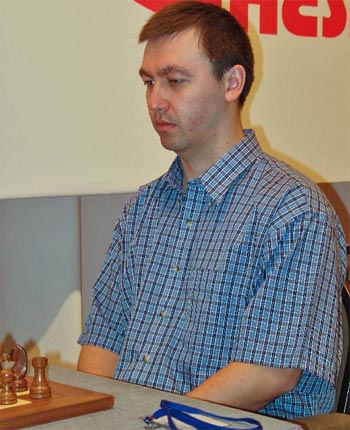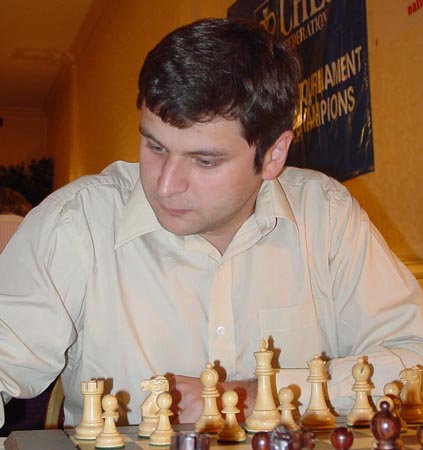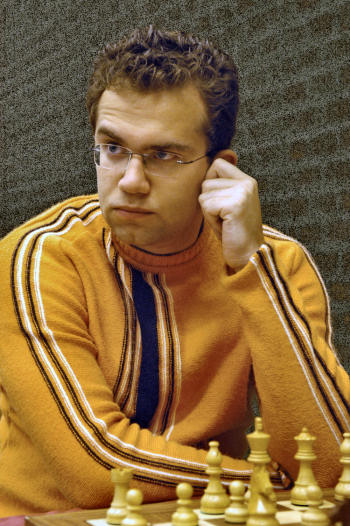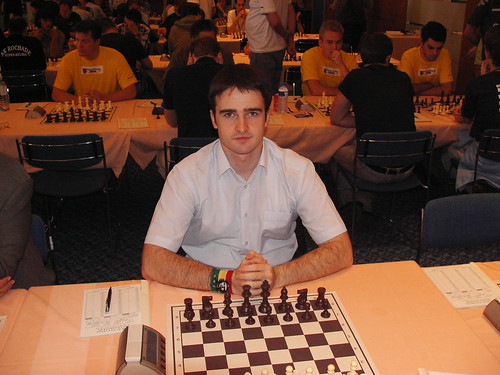| Latest | Greatest | Lobby | Journals | Search | Options | Help | Login |
|
|
|
This topic is archived. |
| Home » Discuss » Topic Forums » Sports |
|
| Jack Rabbit
|
Sun May-23-10 03:31 PM Original message |
| The JR Chess Report (May 23): Is the G. W. Bush of chess stealing the FIDE election? |
|
Edited on Sun May-23-10 03:34 PM by Jack Rabbit
Is Kirsan Stealing the FIDE Election?
  Political intrigue now taking place in Russia would make it appear that Kirsan Ilyumzhinov, the incompetent and corrupt president of both the FIDE, the world chess federation, and the Russian Autonomous Republic of Kalmykia, is attempting to assure his re-election as FIDE president by coup d'etat. Kirsan, known not necessarily affectionately in the world wide chess playing community by his first name, is often called in these reports the "George W. Bush of Chess" for his habit of coming up with big ideas than never seem to pan out or just weren't very good in the first place. To extend the Bush analogy, the part of Florida in recent events is being played by the Russian Chess Federation and the part of Katherine Harris by Arkady Dvorkovich, a top official of the RCF and a supporter of Ilyumzhinov's re-election bid. Al Gore is portrayed by an unlikely performer for the part, former world champion Anatoly Karpov, who is opposing Kirsan in his bid for re-election. There is a very real possibility that somebody in the Russian government is playing the part of Jeb Bush, acting behind the scenes to make sure things come out the way they're supposed to come out, regardless of the will of the voters. One week after a quorum of RCF board members voted to endorse the candidacy of Anatoly Evgenyevich, members of a private security firm invaded the RCF's offices in Moscow, ejected board chairman Alexander Bakh, a Karpov supporter, from his office and seized the federation's bank accounts. The security firm was apparently acting on orders from a government official. Dvorkovich had been claiming all week that the vote of the board members was invalid because he was not present. The fact is that on May 14, the day of the vote, Dvorkovich first tried to change the site of the meeting, then tried to cancel it and then told Kirsan's supporters on the board to not attend in the hopes that it would deny Karpov's supporters a quorum. All such actions failed. Seventeen of the 32-member board met and voted unanimously to endorse Karpov. Prior to the vote, on May 3, Dvorkovich had issued a statement to the effect of the RCF had endorsed Kirsan's candidacy for re-election. Karpov immediately objected, pointing out that no vote had been taken at that time and that Dvorkovich had no authority to sign off on the endorsement in any event. Only the chairman of the RCF board, Bakh, could do that. In order to be elected president of FIDE, a candidate needs to have the support of a delegation of which he is a member. For Karpov, this is not a serious problem, since in addition of being a member of the Russian Federation he is also a member of the German Federation due to the fact he competed in the Bundesliga many years ago. Kirsan, who was a talented youngster in Kalmykia (he was the Kalmykian champion at the age of 14), never became an international star in chess and is a member only of the Russian Federation. There was some talk that he could be nominated by the presidential board, but that appears to have about as much validity as the claims of such Bush Administration constitutional scholars as Dick Cheney and David Addington, who apparently could read invisible ink on the Constitution that nobody else could. The claim would certainly be challenged, and if Kirsan were overruled he would be ineligible for re-election. Other resources: Julia Ioffe in True/Slant ChessBase Mark Crowther (The Week in Chess) Mig Greengard (Chess Ninja) Big Four in Quad Final of US Championship  The "Big Four" of American chess -- Gata Kamsky, Hikaru Nakamura, Alex Onischuk and Yuri Shulman -- are currently taking part in the final phase of the 2010 US Championship in St. Louis, a three-round mini-tournament to determine the new champion. The quadrangular touranament, or the "Quad" as it is called in St. Louis, began yesterday with Nakamura playing White against Kamsky and Onischuk playing White against Shulman. Both games ended in draws. In the round starting as we go to press (2 pm CDT/12 noon PDT), Nakamura plays White against Shulman and Kamsky has White against Onischuk. There is a live broadcast featuring commentary by US grandmaster Maurice Ashley and WGM Jennifer Shahade on the http://saintlouischessclub.org/2010-us-championship">official website of the St. Louis Chess Club and Scholastic Center. The battle for fifth place, called the "challenger tournament," continues today among the 20 other players in the tournament with grandmaster Alex Stripunsky currently a half point ahead of former US champion Alex Shabalov. The challenger tournament concludes today while the Quad is scheduled to finish tomorrow, with speed chess play offs, if necessary, scheduled for Tuesday. Eljanov leads Astrakhan Grand Prix  Ukrainian GM Pavel Eljanov leads the sixth and final leg of the 2008-09 FIDE Grand Prix (being played in May 2010) with one round remaining in the Russian city of Astrakhan in the Volga Delta near the Caspian Sea. Pavel Vladimirovich is assured of at least a share of first prize as he leads a half d0zen other players by a full point and need only avoid loss in the final round to take first place clear. The final round will be played tomorrow. Beginning this week Chicago Open 27-31 May. Calendar Karpov International Tournament, Poikovsky 31 May-14 June. Bacrot, Bologan, Jakovenko, Motylev, Onischuk, Rianzantsev, Rublevsky, Shirov, Ivan Sokolov, Sutivsky, Svidler and Wang Hao. 45th Capablanca Memorial Tournament, Havana 9-22 June. Alekseev, Bruzón, Domínguez, Ivanchuk, Nepomniachtchi and Short. Kings Tournament, Banza 14-24 June. Carlsen, Gelfand, Nisipeanu, Ponomariov, Radjabov and Wang Yue. Women's Grand Prix, Jermuk 23 June-6 July. World Open, Valley Forge, Pennsylvania 29 June-5 July. Sparkassen Chess Meeting, Dortmund 15-25 July. Kramnik, Le Quang Liem, Leko, Mamedyarov, Naiditsch and Ponomariov. Women's Grand Prix, Ulan Bator (Mongolia) 29 July-12 August. World Junior Championships, Chotowa Czarna (Poland) 2-17 August. Mainz Chess Classic 6-8 August. The world economic crisis reduces the festival to three days in 2010, with the rapid open and simultaneous exhibitions by Vishy Anand and Alexandra Kosteniuk being the only featured events. Chess Olympiad, Khanty Mansiysk 19 September-4 October. Pan-American Women's Championship, São Paulo 10-21 October. European Club Cup, Plovdiv 16-24 October. Women's Grand Prix, Vina del Mar (Chile) 27 October-9 November. World Youth Championships, Halidiki (Greece) 19-31 October. FIDE Women's Knock Out (Women's World Championship), Turkey 2-25 December. |
| Printer Friendly | Permalink | | Top |
| Jack Rabbit
|
Sun May-23-10 03:35 PM Response to Original message |
| 1. This Week's Games |
|
Your humble hare acknowledges the assistance of Fritz 6.0 on analysis. Diagrams on the Jack Rabbit Chess Report are made with Chess Mérida, a true type font that can be downloaded free here. !""""""""# $tMvWlVmT% $OoOoOoOo% $ + + + +% $+ + + + % $ + + + +% $+ + + + % $pPpPpPpP% $RnBqKbNr% /(((((((() WHITE White to move (This position is a theoretical draw) I would like to thank my impressive and loyal staff: Buccaneer, Spitfire, Swashbuckler, Pancho and Robin Hood. |
| Printer Friendly | Permalink | | Top |
| Jack Rabbit
|
Sun May-23-10 03:36 PM Response to Reply #1 |
| 2. US Championship, St. Louis |
|
Edited on Sun May-23-10 03:42 PM by Jack Rabbit
|
| Printer Friendly | Permalink | | Top |
| Jack Rabbit
|
Sun May-23-10 03:55 PM Response to Reply #2 |
| 4. Kamsky - Christiansen, Round 5 |
 Gata Kamsky Gata Kamsky - Larry Christiansen US Championship, Round 5 St Louis, 18 May 2010 Spanish Petit Royal Game: Pogo Stick Defense (Bird's Defense) 1.e4 e5 2.Nf3 Nc6 3.Bb5 Bc5
4.0-0 Nd4
5.Ba4 Nxf3+ 6.Qxf3 Ne7
7.Qc3!?
7...Bd4
8.Qg3 Ng6 9.c3 Bb6 10.d4 0-0
11.f4!?
11...exf4!?
12.Bxf4 Nxf4
13.Qxf4
13...d6 14.Nd2 Be6 15.Kh1 c6 16.Nf3 h6 17.Bc2 Qd7 18.e5 dxe5
19.Nxe5 Qd6
20.Qg3 f5!?
21.Rae1 Bc7!?
22.Qh3!
22...f4?
""""""""# $t+ + Tk+% $OoV + O % $ +oWv+ O% $+ + N + % $ + P O +% $+ P + +q% $pPv+ +pP% $+ + Rr+k% /(((((((() WHITE: Gata Kamsky Position after 22...f5f4 23.Qd3!
23...Bf5 24.Bb3+ Kh7 25.Qd2!
25...g5 """"""""# $t+ + T +% $OoV + +l% $ +oW + O% $+ + NvO % $ + P O +% $+bP + + % $pP Q +pP% $+ + Rr+k% /(((((((() WHITE: Gata Kamsky Position after 25...g7g5 26.g4!
26...Bc8
27.Qd3+ Kg7 28.Bc2 Rh8
29.Ng6 Bxg4 30.Re7+ Kf6 31.Rxc7 Rhg8 32.Ne5 1-0
|
| Printer Friendly | Permalink | | Top |
| Jack Rabbit
|
Sun May-23-10 03:56 PM Response to Reply #2 |
| 5. Nakamura - Kraai, Round 6 |
 Hikaru Nakmura Hikaru Nakamura - Jesse Kraai US Championship, Round 6 St Louis, 19 May 2010 Open Queen's Gambit: Catalan Opening 1.d4 Nf6 2.c4 e6 3.g3 d5 4.Bg2 dxc4 5.Nf3 a6 6.Ne5
6...Bb4+
7.Nc3
7...Nd5 8.Bd2 Nb6
9.e3 N8d7 10.Nxd7
10...Qxd7 11.Ne4 Qb5 12.0-0!?
12...0-0
13.a4 Qa5 14.Qe1
14...Bxd2 15.Qxd2 Qxd2!?
16.Nxd2 Bd7 17.a5!?
17...Nd5 18.Rfc1
18...Bb5 19.Bf1 c5 20.dxc5
20...Rfc8
&& 21.Nxc4 Rxc5 22.Nb6!?
""""""""# $t+ + +l+% $+o+ +oOo% $oN +o+ +% $PvTm+ + % $ + + + +% $+ + P P % $ P + P P% $R R +bK % /(((((((() WHITE: Hikaru Nakamura Position after 22.Nc4b6 22...Rxc1!
23.Rxc1 Nxb6 24.axb6 Bc6 25.Bg2 Kf8?
""""""""# $t+ + L +% $+o+ +oOo% $oPv+o+ +% $+ + + + % $ + + + +% $+ + P P % $ P + PbP% $+ R + K % /(((((((() WHITE: Hikaru Nakamura Position after 25...Kg8f8 26.Bxc6!
26...bxc6 27.Rxc6 Rb8 28.f4!
28...Ke7 29.e4 Kd7
30.Rc7+ Kd8
""""""""# $ T L + +% $+ R +oOo% $oP +o+ +% $+ + + + % $ + +pP +% $+ + + P % $ P + + P% $+ + + K % /(((((((() WHITE: Hikaru Nakamura Position after 30...Kd7d8 31.Rxf7!
31...Rxb6 32.Rxg7 Rxb2 33.Rxh7 a5
34.Ra7 Ra2 35.h4 Ke8 36.h5 Kf8 37.h6 Kg8 38.g4 1-0
|
| Printer Friendly | Permalink | | Top |
| Jack Rabbit
|
Sun May-23-10 03:58 PM Response to Reply #2 |
| 6. Onischuk - Akobian, Round 5 |
 Alex Onischuk Alex Onischuk - Var Akobian US Championship, Round 5 St.Louis, 18 May 2010 West India Game: Indian Queen's Gambit (Slav Defense) 1.d4 d5 2.c4 c6 3.Nc3 Nf6 4.e3 g6 5.Nf3 Bg7 6.Bd3
6...0-0 7.0-0 Bg4
8.h3 Bxf3 9.Qxf3 e6 10.Rd1 Nbd7 11.b3 Re8 12.Bb2 Qe7 13.Qe2
13...a6
14.Rac1
14...Rad8 15.Qc2 h5 16.Bf1 Nh7!?
17.e4
17...dxe4
18.Qxe4 Nhf6 19.Qe3 e5
20.d5 cxd5 21.Nxd5 Nxd5 22.Rxd5 e4 23.Bxg7 Kxg7 """"""""# $ + Tt+ +% $+o+nWoL % $o+ + +o+% $+ +r+ +o% $ +p+o+ +% $+p+ Q +p% $p+ + Pp+% $+ R +bK % /(((((((() WHITE: Alex Onischuk Position after 23...Kg8g7:B 24.c5
24...Nf6 25.Rxd8 Rxd8 26.c6
26...bxc6 27.Rxc6 Qe5
""""""""# $ + T + +% $+ + +oL % $o+r+ Mo+% $+ + W +o% $ + +o+ +% $+p+ Q +p% $p+ + Pp+% $+ + +bK % /(((((((() WHITE: Alex Onischuk Position after 27...Qe7e5 28.Qc1!?
28...a5 29.Rc5!?
29...Rd5!
30.Rxd5 Nxd5 31.Qc5 h4?
""""""""# $ + + + +% $+ + +oL % $ + + +o+% $O QmW + % $ + +o+ O% $+p+ + +p% $p+ + Pp+% $+ + +vK % /(((((((() WHITE: Alex Onischuk Position after 31...h5h4 32.Qxa5!
32...e3 33.Qe1
33...Qd4 34.Bc4 Qd2 35.Kf1 Nc3
36.Qxe3 Qd1+
37.Qe1 Qd4
38.Qa1! f6 39.a4 Qd2 40.Qe1 Qd4 41.Qe7+ 1-0
|
| Printer Friendly | Permalink | | Top |
| Jack Rabbit
|
Sun May-23-10 03:59 PM Response to Reply #2 |
| 7. Stripunsky - Shulman, Round 6 |
 Yuri Shulman Alex Stripunsky - Yuri Shulman US Championship, Round 6 St Louis, 19 May 2010 Open French Game: Nimzo-Winawer Defense 1.e4 e6 2.d4 d5 3.Nc3 Bb4 4.Nge2
4...dxe4 5.a3 Bxc3+ 6.Nxc3 Nc6 7.Bb5 Nge7 8.Be3
8...0-0 9.Qd2 f5 10.0-0-0 a6 11.Bxc6 Nxc6 12.f3 e5
13.d5 Na5 14.Qe2 b6!?
15.fxe4
15...f4
16.Bd2 Nb7 17.Rdf1 Nd6 18.g3
18...Bh3 19.Rf2 Bg2 20.Re1 f3 21.Qe3
21...h6 22.Ne2 Qe8 23.Ng1
23...Qh5
24.h3 Bxh3 25.Rxf3!?
""""""""# $t+ + Tl+% $+ O + O % $oO M + O% $+ +pO +w% $ + +p+ +% $P + QrPv% $ PpB + +% $+ K R N % /(((((((() WHITE: Alex Stripunsky Position after 25.Rf1f3:p 25...Bg2!
26.Rxf8+ Rxf8 27.Bb4 Qg4!
28.Bxd6 cxd6 29.Kb1?
""""""""# $ + + Tl+% $+ + + O % $oO O + O% $+ +pO + % $ + +p+w+% $P + Q P % $ Pp+ +v+% $+k+ R N % /(((((((() WHITE: Alex Stripunsky Position after 29.Kc1b1 29...Qxe4!!
30.Qxe4 Bxe4 31.Rxe4 Rf1+!
32.Ka2 Rxg1 33.Rb4
33...b5 34.a4 Rxg3 35.axb5 axb5 36.Rxb5 """"""""# $ + + +l+% $+ + + O % $ + O + O% $+r+pO + % $ + + + +% $+ + + T % $kPp+ + +% $+ + + + % /(((((((() WHITE: Alex Stripunsky Position after 36.Rb3b4:p 36...h5!
37.Rb8+ Kh7 38.b4 h4 39.Rf8
39...h3 40.Rf1 e4 41.b5
41...Rf3 42.Rg1
42...e3 43.b6 e2 44.Re1 h2 45.Rh1 Kg6 0-1
|
| Printer Friendly | Permalink | | Top |
| Jack Rabbit
|
Sun May-23-10 04:38 PM Response to Reply #2 |
| 11. Shabalov - Christiansen, Round 4 |
|
This game is a real slugfest between two veteran heavy hitters. One learned the finer points of chess from Tal himself; the other has just spent forty years playing like he did.
 Larry Christiansen Alex Shabalov - Larry Christiansen US Championship, Round 4 St Louis, 17 May 2010 East India Game: Bogo-Indian Defense 1.d4 Nf6 2.c4 e6 3.Nf3 Bb4+ 4.Nbd2
4...d5
5.Qa4+ Nc6 6.a3 Bxd2+
7.Bxd2 Ne4 8.Be3!?
8...0-0
9.g3 Nd6 10.c5 Nc4 11.Bc1 Qf6 12.Qd1
12...e5 13.b3 e4 14.Bg5
14...Qf5 15.bxc4 exf3 16.Be3 dxc4 17.exf3 Be6
18.Bg2
18...Rfd8 19.0-0 Bd5!?
20.h4?
""""""""# $t+ T +l+% $OoO +oOo% $ +m+ + +% $+ Pv+w+ % $ +oP + P% $P + BpP % $ + + Pb+% $R +q+rK % /(((((((() WHITE: Alex Shabalov Position after 20.h2h4 20...b5!
21.cxb6
21...cxb6 22.a4
22...Nb4 23.Rb1
23...Nd3 24.Rb5
24...Qe6 25.Qc2 Rac8 26.Rfb1 Qc6
27.Qe2
27...Re8 28.a5
""""""""# $ +t+t+l+% $O + +oOo% $ Ow+ + +% $Pr+v+ + % $ +o+ + P% $+ +mBpP % $ + +qPb+% $+r+ + K % /(((((((() WHITE: Alex Shabalov Position after 28.a4a5 28...Nc1!!
29.Qc2
29...Nb3 30.Rxd5 Qxd5 31.axb6 axb6 32.f4 Qd6 33.d5
33...b5 34.f5 Rcd8 35.Bf4
""""""""# $ + Tt+l+% $+ + +oOo% $ + W + +% $+o+p+p+ % $ +o+ B P% $+m+ + P % $ +q+ Pb+% $+r+ + K % /(((((((() WHITE: Alex Shabalov Position after 35.Be3f4 35...Qb6
36.Kh2 Nd4 37.Qxc4 bxc4 38.Rxb6 c3 39.d6
39...c2 40.Rb7 Rxd6 41.Rc7 Rdd8 42.Rc4
42...Re2 43.g4 h5 0-1
|
| Printer Friendly | Permalink | | Top |
| Jack Rabbit
|
Sun May-23-10 03:44 PM Response to Reply #1 |
| 3. FIDE Grand Prix, Astrakhan |
| Printer Friendly | Permalink | | Top |
| Jack Rabbit
|
Sun May-23-10 04:18 PM Response to Reply #3 |
| 8. Inarkiev - Eljanov, Round 7 |
 Pavel Eljanov Ernesto Inarkiev - Pavel Eljanov FIDE Grand Prix, Sixth Leg, Round 7 Astrakhan, 17 May 2010 Closed Caro-Kann Game: Houska Opening 1.e4 c6 2.d4 d5 3.e5 Bf5 4.Nf3 e6 5.Be2 c5 6.Be3 Qb6
7.Nc3 Qxb2
8.Qb1
8...Qxb1+ 9.Rxb1 c4
10.Rxb7 Nc6 11.Kd2!?
11...Bb4
12.Rb1 Ba5 13.g4
13...Bxg4 14.Rxf7 Bxf3 15.Rxf3 Nge7 16.Rg1
16...Rg8 17.Rh3 Nf5 18.Bg4?
""""""""# $t+ +l+t+% $O + + Oo% $ +m+o+ +% $V +oPm+ % $ +oP +b+% $+ N B +r% $p+pK P P% $+ + + R % /(((((((() WHITE: Ernesto Inarkiev Position after 18.Be2g4 18...Ncxd4!
19.Bxd4 Nxd4 20.Kc1
20...Bxc3 21.Rxc3 Ke7 22.f4
""""""""# $t+ + +t+% $+ + L Oo% $ + +o+ +% $+ +oP + % $ +oM Pb+% $+ R + + % $p+p+ + P% $+ K + R % /(((((((() WHITE: Ernesto Inarkiev Position after 22.f2f4 22...g6!
23.Rh3 Rg7 24.Kd2 Rf7 25.Rb1 Rd8!
26.c3
26...Nc6 27.Ke3
""""""""# $ + T + +% $O + Lt+o% $ +m+o+o+% $+ +oP + % $ +o+ Pb+% $+ P K +r% $p+ + + P% $+r+ + + % /(((((((() WHITE: Ernesto Inarkiev Position after 27.Kd2e3 27...h5!?
28.Be2 Kf8 29.Rg3
29...Ne7 30.Rgg1
30...d4+ 31.cxd4 Nd5+ 32.Kd2
32...Nxf4 33.Bxc4 Rxd4+ 34.Kc3 Rd8
35.Kb4
35...Kg7 36.Rgd1 Rc8 37.Bb3
""""""""# $ +t+ + +% $O + +tL % $ + +o+o+% $+ + P +o% $ K + M +% $+b+ + + % $p+ + + P% $+r+r+ + % /(((((((() WHITE: Ernesto Inarkiev Position after 37.Bc4b3 37...Rb7+!
38.Ka5
38...Rc5+ 39.Ka6 Rf7 40.Rd6 Rxe5 41.Rbd1
41...Re2 42.Rd7
42...Rxh2 43.Kxa7 Rb2 44.Rxf7+
44...Kxf7 45.Kb6 g5 46.Kc5
46...h4 47.Kb4 Nd5+ 48.Kc5 h3 49.Bxd5
49...exd5 50.Kxd5 Re2 0-1
|
| Printer Friendly | Permalink | | Top |
| Jack Rabbit
|
Sun May-23-10 04:19 PM Response to Reply #3 |
| 9. Eljanov - Ponomariov, Round 8 |
 Ruslan Ponomariov Pavel Eljanov - Ruslan Ponomariov FIDE Grand Prix, Sixth Leg, Round 8 Astrakhan, 18 May 2010 East India Game: Bogo-Indian Defense (Catalan Opening) 1.d4 Nf6 2.c4 e6 3.g3 d5 4.Bg2 Bb4+ 5.Bd2 Bd6
6.Nf3 c6 7.0-0 Nbd7 8.Qc2 0-0 9.Bg5
9...h6 10.Bxf6 Nxf6
11.Nbd2 b6 12.e4 Be7
13.e5!?
13...Nd7
14.cxd5 cxd5 15.Rfc1 Bb7 16.Qc7 Ba6 17.a4
17...Bb4
18.Qxd8 Rfxd8 19.Rc7 Kf8
20.Bf1 Bxf1 21.Nxf1 Ke8 22.Rac1 Rdb8
23.Ne1!?
""""""""# $tT +l+ +% $O R +oO % $ O +o+ O% $+ +oP + % $pV P + +% $+ + + P % $ P + P P% $+ R NnK % /(((((((() WHITE: Pavel Eljanov Position after 23.Nf3e1 23...b5!
24.axb5 Ba5 25.R7c2 Rxb5
26.Nd2
26...Nb6
27.Nd3?!
""""""""# $t+ +l+ +% $O + +oO % $ M +o+ O% $Vt+oP + % $ + P + +% $+ +n+ P % $ PrN P P% $+ R + K % /(((((((() WHITE: Pavel Eljanov Position after 27.Ne1d3 27...Bxd2!
28.Rxd2 Nc4 29.Rdc2 a5
30.Kf1 Rab8 31.Ra1
31...f6 32.Re2 Kf7 33.exf6 gxf6 34.Rae1
34...R8b6 35.Nf4?
""""""""# $ + + + +% $+ + +l+ % $ T +oO O% $ot+o+ + % $ +mP N +% $+ + + P % $ P +rP P% $+ + Rk+ % /(((((((() WHITE: Pavel Eljanov Position after 35.Nd3f4 35...e5!
36.dxe5
36...fxe5 37.b3 exf4 38.bxc4 dxc4
39.Re7+ Kg6 40.Rc7 Rb4 41.Kg2
41...a4 42.Ree7
""""""""# $ + + + +% $+ R R + % $ T + +lO% $+ + + + % $oTo+ O +% $+ + + P % $ + + PkP% $+ + + + % /(((((((() WHITE: Pavel Eljanov Position after 42.Re1e7 42...Ra6
43.g4
43...a3 44.Rg7+ Kf6 45.Rce7 a2 46.Rgf7+ Kg5 47.Rf5+ Kxg4 48.Ree5 Rb3 0-1
|
| Printer Friendly | Permalink | | Top |
| Jack Rabbit
|
Sun May-23-10 04:20 PM Response to Reply #3 |
| 10. Gelfand - Inarkiev, Round 6 |
 Ernesto Inarkiev Boris Gelfand - Ernesto Inarkiev FIDE Grand Prix, Sixth Leg, Round 6 Astrakhan, 16 May 2010 Semi-Slav Queen's Gambit: Stoltz Opening 1.d4 d5 2.c4 c6 3.Nc3 Nf6 4.e3 e6 5.Nf3 Nbd7 6.Qc2 Bd6 7.Bd3 0-0 8.0-0 dxc4 9.Bxc4 b5 10.Be2 Bb7 11.Rd1 Qc7
12.e4
12...e5 13.dxe5
13...Nxe5 14.Nd4 Neg4!?
15.g3!?
15...Bc5 16.Bxg4 Nxg4 17.Bf4 Qb6 18.Nce2 Rfe8 19.a4!?
""""""""# $t+ +t+l+% $Ov+ +oOo% $ Wo+ + +% $+oV + + % $p+ NpBm+% $+ + + P % $ Pq+nP P% $R +r+ K % /(((((((() WHITE: Boris Gelfand Position after 19.a2a4 19...a6
20.a5 Qa7 21.f3
21...Ne5!?
22.Kg2 Bf8 23.Nf5
23...c5 24.Nc3 c4! 25.Bxe5!?
25...Rxe5 26.Qc1!?
26...b4 27.Qf4
""""""""# $t+ + Vl+% $Wv+ +oOo% $o+ + + +% $P + Tm+ % $ Oo+pW +% $+ N +pP % $ P + +kP% $R +r+ + % /(((((((() WHITE: Boris Gelfand Position after 27.Qc1f4 27...Rxf5!!
28.Qxf5 Bc8 29.Qe5 bxc3
30.bxc3 Qb8 31.Qxb8 Rxb8
32.Rd4?
""""""""# $ Tv+ Vl+% $+ + +oOo% $o+ + + +% $P + + + % $ +oRp+ +% $+ P +pP % $ + + +kP% $R + + + % /(((((((() WHITE: Boris Gelfand Position after 32.Rd1d4 32...Rb2+!
33.Kh1 Bh3 34.Rg1
34...Be6 35.Rd8 g6
36.Ra8 Kg7 37.g4 Rf2 38.Rxa6 Rxf3 39.Rc6
39...Rxc3 40.Rg3 Rc1+ 41.Rg1
""""""""# $ + + V +% $+ + +oLo% $ +r+v+o+% $P + + + % $ +o+p+p+% $+ + + + % $ + + + P% $+ T + Rk% /(((((((() WHITE: Boris Gelfand Position after 41.Rg3g1 41...Rc3!
42.Rg3 Rd3 43.Rxd3
43...cxd3 44.Rc3 d2 45.Rd3 Bb4 46.a6 Bc8!
47.a7
47...Bb7 48.Kg1 Bc5+ 49.Kf1 Ba6 0-1
|
| Printer Friendly | Permalink | | Top |
| Jack Rabbit
|
Tue May-25-10 12:52 PM Response to Original message |
| 12. Updates (Tuesday): Gata Kamsky new US National Champion |
|
Edited on Tue May-25-10 12:53 PM by Jack Rabbit
 Gata Kamsky, a Soviet-born American of Tatar descent, won his first US national championship since the early 1990s minutes ago when he defeated his friend and training partner Yuri Shulman in a rapid Armageddon game in St. Louis. Shulman, who was also born in the old Soviet Union, drew Kamsky yesterday in the final round of the quadrangular championship to tie Kamsky for first place. In today's game, the players started with a base time of 60 minutes, but put in bids of time for the right play Black with the odds of draw (meaning that for Black a draw would be as good as an outright victory). Shulman, not noted for his speed chess skills, all but conceded Black to Kamsky by bidding 40 minutes while Kamsky bid 25, which some commentators thought very low. Shulman played a solid Queen's pawn opening which morphed into a Slav-Grünfeld Defense and appeared to have the upper hand by about the thirtieth move. However, an inaccuracy allowed Kamsky to equalize if not get the better game. On the 66th move Shulman, seeing he could not win the game, agreed to a draw. Kamsky last won the US Championship in 1991. Eljanov wins Astrakahn Grand Prix  Ukrainian grandmaster Pavel Eljanov took first place in the sixth and final leg of 2008-09 FIDE Grand Prix (yes, we know it's the end of May 2010) yesterday with 8 points out of 13 rounds in the city of Astrakhan in the Volga Delta. Pavel Vladimirovich finished a full point ahead of fellow Ukrainian GM Ruslan Ponomariov, Russians Dmitry Jakovenko and Evgeny Alekseev, former two-time junior world champion Shakhriyar Mamedyarov of Azerbaijan and Teimour Rajabov, also from Azerbaijan. The Grand Prix series was won by Armenian grandmaster Levon Aronian, who did not participate in Astrakhan having already cinched the title. While FIDE has not yet posted the final results, it appears that second place will go to Rajabov. Chinese Championships begin in Xinghua  The annual Chinese National Chess Championships began yesterday in Xinghua in Jiangsu province. The defending champion in the general group is Ding Liren, who last year was untitled but this year competes as a grandmaster. Ding is off to a poor start, losing in the first round to last year's runner up, Wang Hao, and in today's second round to Ni Hua. The leaders after two rounds are Bu Xiangzhi and Li Shilong with perfect scores. As last year, it is indeed improper to refer to the general group as the "men's group," as Hou Yifan is again playing with the guys. Shen Yang is the defending women's champion. The leaders after two rounds are Gu Xiaobing, Huang Qian, Ju Wenjun and Wang Doudou with a point and a half each. |
| Printer Friendly | Permalink | | Top |
| DU
AdBot (1000+ posts) |
Sat May 04th 2024, 11:48 PM Response to Original message |
| Advertisements [?] |
| Top |
| Home » Discuss » Topic Forums » Sports |
|
Powered by DCForum+ Version 1.1 Copyright 1997-2002 DCScripts.com
Software has been extensively modified by the DU administrators
Important Notices: By participating on this discussion board, visitors agree to abide by the rules outlined on our Rules page. Messages posted on the Democratic Underground Discussion Forums are the opinions of the individuals who post them, and do not necessarily represent the opinions of Democratic Underground, LLC.
Home | Discussion Forums | Journals | Store | Donate
About DU | Contact Us | Privacy Policy
Got a message for Democratic Underground? Click here to send us a message.
© 2001 - 2011 Democratic Underground, LLC